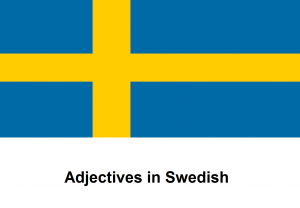Difference between revisions of "Language/Swedish/Grammar/Adjectives"
m (Quick edit) |
m (Quick edit) |
||
| Line 200: | Line 200: | ||
|} | |} | ||
[[File:adjective-swedish.jpg|thumb]] | [[File:adjective-swedish.jpg|thumb]] | ||
'''Alert:''' Before you take this lesson on Swedish adjectives, make sure you have already taken the lesson on [[Language/Swedish/Grammar/When-use-Ett-or-En|Swedish nouns (Ett or En)]]! 📚 | |||
In Swedish, adjectives are conjugated depending on the noun that is being described, just like in English. To further enhance your understanding of Swedish grammar, you can also explore other related topics such as [[Language/Swedish/Grammar/Plural-nouns|Swedish plural nouns]], the comprehensive guide to [[Language/Swedish/Grammar|Swedish Grammar]], and the concept of [[Language/Swedish/Grammar/Negation|Negation]] in Swedish. Happy learning! 🇸🇪✨ | |||
=='''Adjective: beautiful'''== | =='''Adjective: beautiful'''== | ||
| Line 255: | Line 250: | ||
<youtube>https://www.youtube.com/watch?v=TfRhnTDIul4</youtube> | <youtube>https://www.youtube.com/watch?v=TfRhnTDIul4</youtube> | ||
== | ==Other Lessons== | ||
* [[Language/Swedish/Grammar/How-to-express-disagreement|How to express disagreement]] | * [[Language/Swedish/Grammar/How-to-express-disagreement|How to express disagreement]] | ||
* [[Language/Swedish/Grammar/How-to-Use-Have|How to Use Have]] | * [[Language/Swedish/Grammar/How-to-Use-Have|How to Use Have]] | ||
| Line 266: | Line 261: | ||
* [[Language/Swedish/Grammar/How-to-Talk-About-How-Something-Smells|How to Talk About How Something Smells]] | * [[Language/Swedish/Grammar/How-to-Talk-About-How-Something-Smells|How to Talk About How Something Smells]] | ||
* [[Language/Swedish/Grammar/Nouns|Nouns]] | * [[Language/Swedish/Grammar/Nouns|Nouns]] | ||
<span links></span> | |||
Revision as of 22:38, 24 March 2023
.
Hello everybody,
In today's lesson you will learn some useful vocabulary about ¨ADJECTIVES¨ in Swedish
Feel free to edit this page by adding new words and expressions !
Good learning ! :)
.
.
Adjectives in Swedish
| ENGLISH | SWEDISH | PRONUNCIATION IN
ENGLISH |
BRAZILIAN
PORTUGUESE |
| big (m) / | stor | stoh | grande / |
| big (f) | stor | stoh | grande (fem) |
| other (m) / | annat | ahn naht | outro / |
| other (f) | annat | ahn naht | outra |
| large (m) / | stor | stoh | largo / |
| large (f) | stor | stoh | larga |
| heavy (m) / | tung | Toon | pesado / |
| heavy (f) | tung | Toon | pesada |
| small (m) / | liten | lew tehn | pequeno / |
| small (f) | liten | lew tehn | pequena |
| short (m) / | kort | kohrt | curto / |
| short (f) | kort | kohrt | curta |
| thin (m) / | tunn | toon | magro / |
| thin (f) | tunn | toon | magra |
| good (m) / | bra | broh | bom / |
| good (f) | bra | broh | boa |
| dry (m) / | torr | tohr | seco / |
| dry (f) | torr | tohr | seca |
| dirty (m) / | smutsig | smou tsihk | sujo / |
| dirty (f) | smutsig | smou tsihk | suja |
| wet (m) / | våt | voht | úmido / |
| wet (f) | våt | voht | úmida |
| correct (m) / | rätt | reht | correto / |
| correct (f) | rätt | reht | correta |
| old (m) / | gammal | gah mahl | velho / |
| old (f) | gammal | gah mahl | velha |
| new (m) / | ny | new | novo / |
| new (f) | ny | new | nova |
| full (m) / | full | fool | cheio / |
| full (f) | full | fool | cheia |
| cold (m) / | kall | kahl | frio / |
| cold (f) | kall | kahl | fria |
| warm (m) / | varm | vahrm | quente / |
| warm (f) | varm | vahrm | quente (fem) |
Alert: Before you take this lesson on Swedish adjectives, make sure you have already taken the lesson on Swedish nouns (Ett or En)! 📚
In Swedish, adjectives are conjugated depending on the noun that is being described, just like in English. To further enhance your understanding of Swedish grammar, you can also explore other related topics such as Swedish plural nouns, the comprehensive guide to Swedish Grammar, and the concept of Negation in Swedish. Happy learning! 🇸🇪✨
Adjective: beautiful
- A beautiful house.
- A beautiful girl.
- Two beautiful paintings.
The adjective doesn't change!
Now, look at the Swedish example:
Adjective: vacker
- Ett vackert hus.
a -t is added because "hus" is an "ett-word"
- En vacker flicka.
the adjective does not need to be conjugated when describing "en-words"
- Två vackra tavlor.
we remove -er and add -ra, to show that this word is in plural.
Let's look at another example:
Adjective: stor (eng: big)
- Ett stort bord. (eng: a big table)
- En stor skola. (eng: a big school)
- Två stora hästar. (eng: two big horses)
Can you tell the difference now?
Authors
Videos
Learn Swedish, Lesson 7: Adjectives - YouTube
Other Lessons
- How to express disagreement
- How to Use Have
- Time References
- How to Get Someone's Attention
- How Often or Seldom You Do Something
- Common Interjections
- Past Tense
- Present Tense
- How to Talk About How Something Smells
- Nouns

